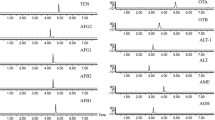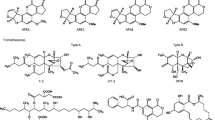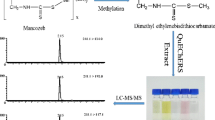Abstract
According to current demands and future perspectives in food safety, this study reports a fast and fully automated analytical method for the simultaneous analysis of the mycotoxins with high toxicity and wide spread, aflatoxins (AFs) and ochratoxin A (OTA) in dried fruits, a high-risk foodstuff. The method is based on pressurized liquid extraction (PLE), with aqueous methanol (30 %) at 110 °C, of the slurried dried fruit and online solid-phase extraction (online SPE) cleanup of the PLE extracts with a C18 cartridge. The purified sample was directly analysed by ultra-high-pressure liquid chromatography–tandem mass spectrometry (UHPLC–MS/MS) for sensitive and selective determination of AFs and OTA. The proposed analytical procedure was validated for different dried fruits (vine fruit, fig and apricot), providing method detection and quantification limits much lower than the AFs and OTA maximum levels imposed by EU regulation in dried fruit for direct human consumption. Also, recoveries (83–103 %) and repeatability (RSD < 8, n = 3) meet the performance criteria required by EU regulation for the determination of the levels of mycotoxins in foodstuffs. The main advantage of the proposed method is full automation of the whole analytical procedure that reduces the time and cost of the analysis, sample manipulation and solvent consumption, enabling high-throughput analysis and highly accurate and precise results.

Fully automated analysis of aflatoxins and ochratoxin A in dried fruits







Similar content being viewed by others
References
Bhat R, Rai RV, Karim AA (2010) Mycotoxins in food and feed: present status and future concerns. Compr Rev Food Sci F 9:57–81
Shephard GS (2009) Aflatoxin analysis at the beginning of the twenty-first century. Anal Bioanal Chem 395:1215–1224
Krska R, Molinelli A (2007) Mycotoxin analysis: state-of-the-art and future trends. Anal Bioanal Chem 387:145–148
Sharma RP (1993) Immunotoxicity of mycotoxins. J Dairy Sci 76:892–897
Van Egmond HP, Schothorst RC, Jonker MA (2007) Regulations relating to mycotoxins in food. Anal Bioanal Chem 389:147–157
IARC, International Agency for Research on Cancer (2002) In IARC monographs on the evaluation of carcinogenic risks to humans 82:171–300
IARC, International Agency for Research on Cancer (2012) In IARC monographs on the evaluation of carcinogenic risks to humans 110 F:225–248
IARC, International Agency for Research on Cancer (1993) In IARC monographs on the evaluation of carcinogenic risks to humans 56:489–521
Trucksess MW, Scott PM (2008) Mycotoxins in botanicals and dried fruits: a review. Food Addit Contam 25:181–192
Commission Regulation (EC) No 1881/2006 (2006) Off J Eur Union L364:5–24
Commission Regulation (EC) No 165/2010 (2010) Off J Eur Union L50:8–12
Commission Regulation (EC) No 401/2006 (2006) Off J Eur Union L70:12–34
Zöllner P, Mayer-Helm B (2006) Trace mycotoxin analysis in complex biological and food matrices by liquid chromatography–atmospheric pressure ionisation mass spectrometry. J Chromatogr A 1136:123–169
Krska R, Schubert-Ullrich P, Molinelli A, Sulyok M, MacDonald S, Crews C (2008) Mycotoxin analysis: an update. Food Addit Contam 25:152–163
Ridgway K, Lalljie SPD, Smith RM (2007) Sample preparation techniques for the determination of trace residues and contaminants in foods. J Chromat A 1153:36–53
Pan J, Zhang C, Zhang Z, Li G (2014) Review of online coupling of sample preparation techniques with liquid chromatography. Anal Chim Acta 815:1–15
Carabias-Martinez R, Rodriguez-Gonzalo E, Revilla-Ruiz P, Hernandez-Mendez J (2005) Pressurized liquid extraction in the analysis of food and biological samples. J Chromat A 1089:1–17
Runnqvist H, Bak SA, Hansen M, Styrishave B, Halling-Sørensen B, Björklund E (2010) determination of pharmaceuticals in environmental and biological matrices using pressurised liquid extraction—are we developing sound extraction methods? J Chromat A 1217:2447–2470
D’Arco G, Fernández-Franzón M, Font G, Damiani P, Mañes J (2008) Analysis of fumonisins B (1), B (2) and B (3) in corn-based baby food by pressurized liquid extraction and liquid chromatography/tandem mass spectrometry. J Chromat A 1209:188–194
Campone L, Piccinelli AL, Aliberti L, Rastrelli L (2009) Application of pressurized liquid extraction in the analysis of aflatoxins B1, B2, G1 and G2 in nuts. J Sep Sci 32:3837–3844
Zinedine A, Blesa J, Mahnine N, El Abidi A, Montesano D, Mañes (2010) Pressurized liquid extraction coupled to liquid chromatography for the analysis of ochratoxin A in breakfast and infants cereals from Morocco. J Food Control 21:132–135
Chen D, Cao X, Tao Y, Wu Q, Pan Y, Huang L, Wang X, Wang Y, Peng D, Liu Z, Yuan Z (2012) Development of a sensitive and robust liquid chromatography coupled with tandem mass spectrometry and a pressurized liquid extraction for the determination of aflatoxins and ochratoxin A in animal derived foods. J Chromat A 1253:110–119
Bovanova L, Brandsteterova E (2000) Direct analysis of food samples by high-performance liquid chromatography. J Chromat A 880:149–168
Rodriguez-Mozaz S, Lopez de Alda MJ, Barcelo D (2007) Advantages and limitations of on-line solid phase extraction coupled to liquid chromatography–mass spectrometry technologies versus biosensors for monitoring of emerging contaminants in water. J Chromat A 1152:97–115
Rogeberg M, Malerod H, Roberg-Larsen H, Aass C, Wilson SR (2014) On-line solid phase extraction–liquid chromatography, with emphasis on modern bioanalysis and miniaturized systems. J Pharmac Biomed Anal 87:120–129
Imperato R, Campone L, Piccinelli AL, Veneziano A, Rastrelli L (2011) Survey of aflatoxins and ochratoxin a contamination in food products imported in Italy Food Control. Food Control 22:1905–1910
Commision Decision 2002/657/EC (2002) Off J Eur Comm L221:8–36
Campone L, Piccinelli AL, Celano R, Rastrelli L (2012) pH-controlled dispersive liquid–liquid microextraction for the analysis of ionisable compounds in complex matrices: case study of ochratoxin A in cereals. Anal Chim Acta 754:61–66
Matuszewski BK, Constanzer ML, Chavez-Eng CM (2003) Strategies for the assessment of matrix effect in quantitative bioanalytical methods based on HPLC-MS/MS. Anal Chem 75:3019–3030
Niessen WMA, Manini P, Andreoli R (2006) Matrix effects in quantitative pesticide analysis using liquid chromatography–mass spectrometry. Mass Spectrom Rev 25:881–899
Campone L, Piccinelli AL, Celano R, Rastrelli L (2013) Rapid analysis of aflatoxin M1 in milk using dispersive liquid–liquid microextraction coupled with ultrahigh pressure liquid chromatography tandem mass spectrometry. Anal Bioanal Chem 405:8645–8652
Acknowledgments
The project was funded by the Italian Ministry of the University and Research (MIUR) with a FIRB “Futuro in Ricerca” Project n. RBFR10GSJK “Tecniche Analitiche Avanzate per l’Analisi dei Contaminanti negli Alimenti”.
Author information
Authors and Affiliations
Corresponding author
Electronic supplementary material
Below is the link to the electronic supplementary material.
ESM 1
(PDF 67 kb)
Rights and permissions
About this article
Cite this article
Campone, L., Piccinelli, A.L., Celano, R. et al. A fully automated method for simultaneous determination of aflatoxins and ochratoxin A in dried fruits by pressurized liquid extraction and online solid-phase extraction cleanup coupled to ultra-high-pressure liquid chromatography–tandem mass spectrometry. Anal Bioanal Chem 407, 2899–2911 (2015). https://doi.org/10.1007/s00216-015-8518-4
Received:
Revised:
Accepted:
Published:
Issue Date:
DOI: https://doi.org/10.1007/s00216-015-8518-4




